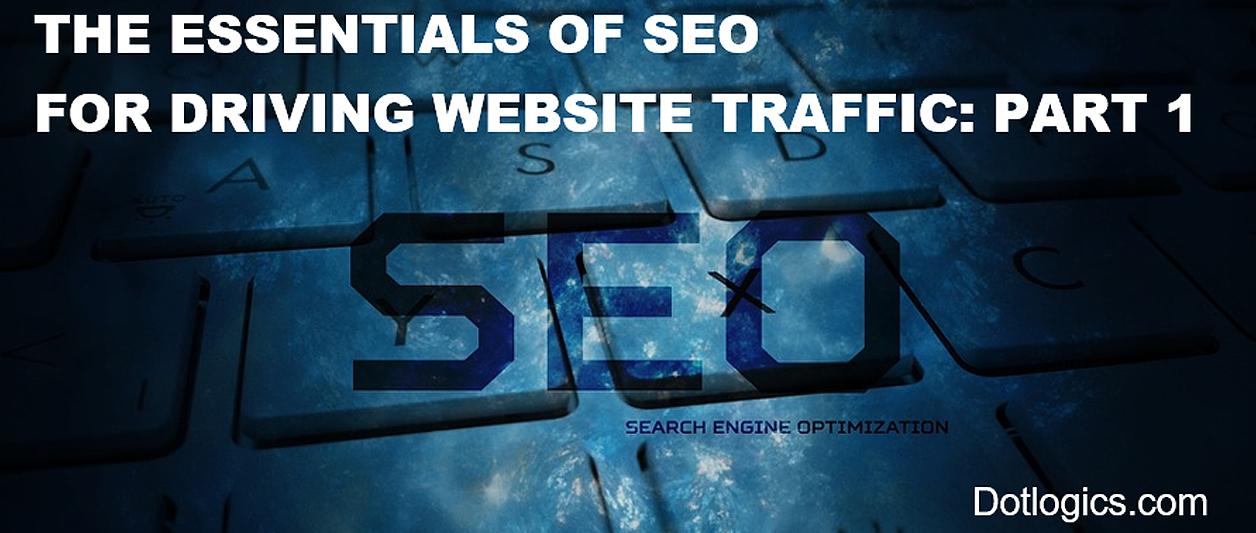
SEO and organic Web traffic matter. Just ask the 61% of marketers who say that boosting SEO and growing organic traffic are their most important inbound digital marketing strategies.
Get the infographic!
To keep your SEO and organic search efforts operating at peak performance, you need to cover the essentials. Use this two-part quick guide as a starting point for the basic framework needed to help optimize your Web content, drive quality lead traffic and ramp up conversions. Here in part one, we’ll look at how content, on-page SEO, meta descriptions and URLs factor into the big picture.
Here goes:

Create (Relevant) High-Quality Content
Whatever type of content you produce, it should offer value to readers and appeal to the interests.
To make sure it does, do the following:
- Conduct keyword research. Do your homework using a powerful tool like Ahrefs to find the terms, phrases and topics that relate to your target audience.
- Google keywords. After settling on keywords, use Google to determine if they are tied to people wanting to learn or buy something, then use it as a content guide.
While crafting effective content, there is one pitfall you should be aware of, which is:
- Duplicate content. Having Web pages with the same or too similar content is one of the biggest reasons site lose traffic and fall in search engine rankings.
Why? When Google's robots crawl your site and find similar content on two different pages, it will prioritize them based on relevance and originality. As a result, only one page will find its way on to SERPs, hurting SEO (in some cases, your site will even be penalized for duplicate content, and be pushed
down in results).After content is created, another thing to think about is the URLs of the pages where content lives. A piece of advice:
- Watch your URL length. Although it’s tempting to use the entire name of your article in a URL, keep an eye out for URLs that are getting too long. Long URLs can be truncated in search results and deter users from clicking. Shorter URLs are easier to share socially and are more readable.

Do On-page Search Engine Optimization (SEO)
Ensure that the content you create is search engine-friendly by:
- Beefing up word count. Pages with a low word count that is too low generally lacks the depth necessary for higher search engine rankings, though content relevance and keyword targeting
matter most. - Using Headlines, Subheadings & Lists. Breaking up your content into easily digestible sections makes it easier to read (when doing so, be sure to include your target keyword or phrases to headlines, if appropriate).
- Fine Tuning Title Tags. Make sure that each Web page has a keyword-rich title tag (name of your page), which search engines use to determine how content is useful to would-be visitors.
When addressing title tags, be on the lookout of the following problems:
- MIA title tags. Since both search engines and Web users rely on them, missing titles hurt a site's ability to rank highly on search engine results pages (SERPs)
- Duplicate and multiple tags. Having more than one title tag leave search engines unable to determine how relevant the pages of your website are to users.
- Title Tags That Are Too Long. If your site has tags longer than 65 characters, some search engines will truncate them in search engine results, hurting user experience.

- Beefing up word count. Pages with a low word count that is too low generally lacks the depth necessary for higher search engine rankings, though content relevance and keyword targeting
Include Appropriate Descriptions
Creating effective (compelling) descriptions will help to engage searchers and drive higher click-through rates.
So, always:
- Include meta descriptions. Having relevant meta descriptions—the text located underneath the title tag on search engine result pages—provide vital information to help Web user decide whether or not to click through to your website. As with title tags, look out for duplicate descriptions, which can confuse Google and other search engines, lowering traffic to your site.
- Add image tags. Not only do images add visual interest to text-based content, including image descriptions allows search engines to index your website's non-text content, which helps to boost overall SEO. And as a bonus, image alt tags make it easy for visually-impaired Web users to access your site with screen readers and other assistive tech devices.

Optimize All URLs
Every website URL should be optimized for both search engines and readers.To make sure they are, be sure to:
- Add keywords. Include relevant keywords in the URL slug that aligns with page content, making it a long-tail search term in itself. This will not only boost SEO, but help make the URL both people- and search engine-friendly, ensuring readers and search bots know exactly what’s on any given page.
- Remove extra words. For reasons of brevity and readability, take out any words that do not add meaning or value to the URL, such as “and,” “that” or anything else not helpful to potential visitors or search engines.
- Do a length check. While it may seem best to the include the entire title of your blog post or article, URLs that are too long can be cut off in search results, leading to fewer click-throughs. Besides, shorter URLs are easier to read and share on social media (50 to 60 characters is a good number to shoot for).
- Use hyphens, not underscores. When separating words in URLs, opt for hyphen instead of underscores, since they enhance readability.
Conclusion
Hopefully, this first installment of best practices will get you off to a good start with website SEO. Be sure to catch our next post for even more insight to ensure you are ready to take full advantage of every opportunity to increase your site's visibility and rankings—leading to more visits, leads, and
ultimately, sales.
-
Search engine optimization can be complicated. Dotlogics has vast experience using SEO to organically increase website traffic.
Let's Get to Work.
Have an unsolvable problem or audacious idea?
